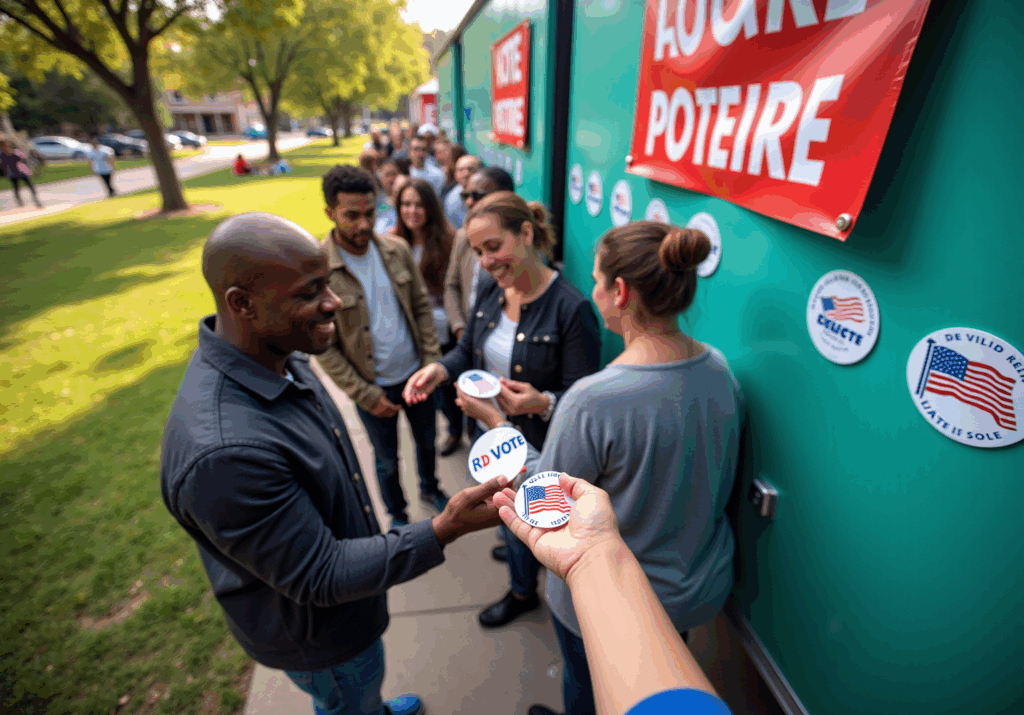Overview
The article centers on various voting incentives designed to enhance union member engagement in the electoral process. It introduces strategies such as:
- Mobile polling stations
- Financial rewards
- Transparent communication
These approaches not only increase participation rates but also foster a sense of community and trust among members. Consequently, they render the voting experience more accessible and meaningful. Union leadership must recognize the potential of these incentives to galvanize member involvement and strengthen democratic processes within the organization.
Introduction
Enhancing voter engagement within unions is essential for fostering a vibrant democratic process. Yet, many organizations face significant challenges in motivating their members to participate in elections. By exploring innovative voting incentives, unions can not only increase participation rates but also cultivate a culture of civic responsibility among their members.
What strategies can effectively bridge the gap between apathy and active involvement in the electoral process? This article delves into ten compelling examples of voting incentives designed to boost union member engagement, revealing how these initiatives can transform the landscape of participation and ensure every voice is heard.
Votem: Secure Online Voting Platform for Enhanced Voter Engagement
Votem’s CastIron platform stands as a robust solution designed to enable secure and compliant online voting, making it particularly advantageous for organizations seeking to enhance participant engagement. By leveraging advanced technology, Votem ensures that elections are not only accessible but also secure and transparent—elements that are essential for fostering trust among groups.
The platform’s mobile-first approach is one of the voting incentives examples that empowers members to vote conveniently, whether they are at home, in the office, or on the go, thereby significantly boosting participation rates. Moreover, features such as encrypted ballots and an immutable audit trail demonstrate Votem’s commitment to regulatory compliance while promoting a culture of accountability and trust within organizations.
As noted by satisfied clients, Votem’s innovative solutions have effectively managed substantial voting volumes, showcasing their capability in enhancing electoral confidence and engagement.
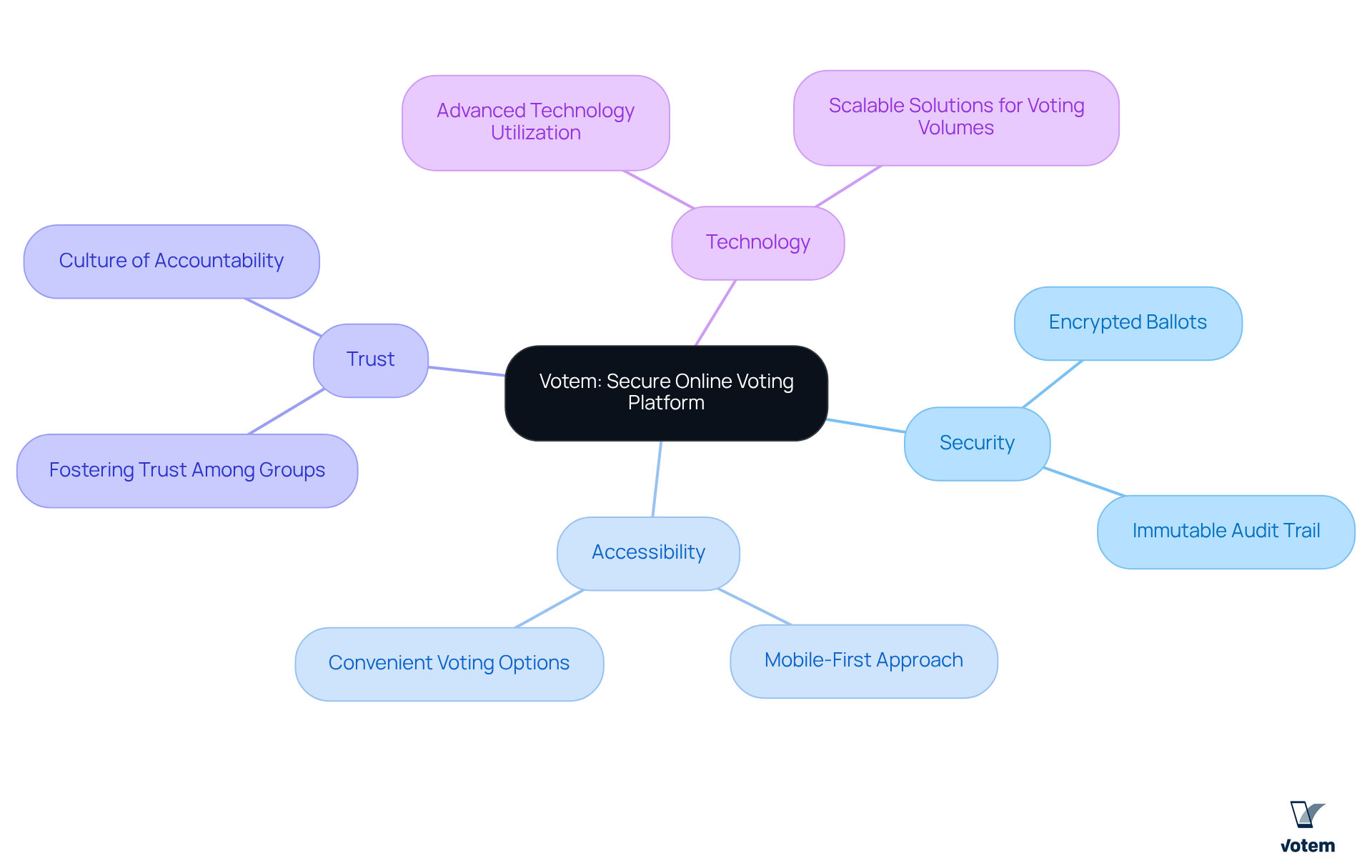
Monetary Incentives: Boosting Voter Turnout Through Financial Rewards
Providing financial rewards, such as gift cards or cash bonuses, can be considered voting incentives examples that significantly enhance voter participation among affiliated workers. By offering voting incentives examples for involvement, unions can effectively motivate participants to engage in the electoral process. This approach not only increases turnout but also reinforces the value of each vote, making members feel that their participation is both recognized and appreciated.
Recent studies indicate that voting incentives examples, including financial incentives, can lead to a substantial rise in ballot participation. For instance, voting incentives examples like initiatives that offer cash incentives for participation have demonstrated an increase in turnout rates by as much as 20%. Union officials have echoed this sentiment, noting that when participants are encouraged, they are more inclined to prioritize their electoral duties. Paul Schiff Berman, a law professor at George Washington University, emphasizes that while financial incentives can enhance participation, they must be structured carefully to avoid legal pitfalls.
Numerous instances serve as voting incentives examples that illustrate how financial incentives have effectively motivated collective voting. In one case, a labor union introduced voting incentives examples by providing $100 to members who participated in elections, resulting in a remarkable 30% increase in turnout compared to prior years. Such initiatives not only drive engagement but also cultivate a culture of participation, ensuring that every voice is heard and counted in the electoral process. However, it is crucial to consider the legal implications of such incentives. Former FEC chairman Brad Smith highlights that while encouraging participation can be effective, it must comply with electoral laws to avert potential legal challenges. Furthermore, the recent initiative by Elon Musk’s America PAC, which offers substantial financial rewards for citizen participation, serves as a voting incentives examples that exemplifies how financial incentives are being utilized in the electoral process, raising essential discussions about their legality and effectiveness.
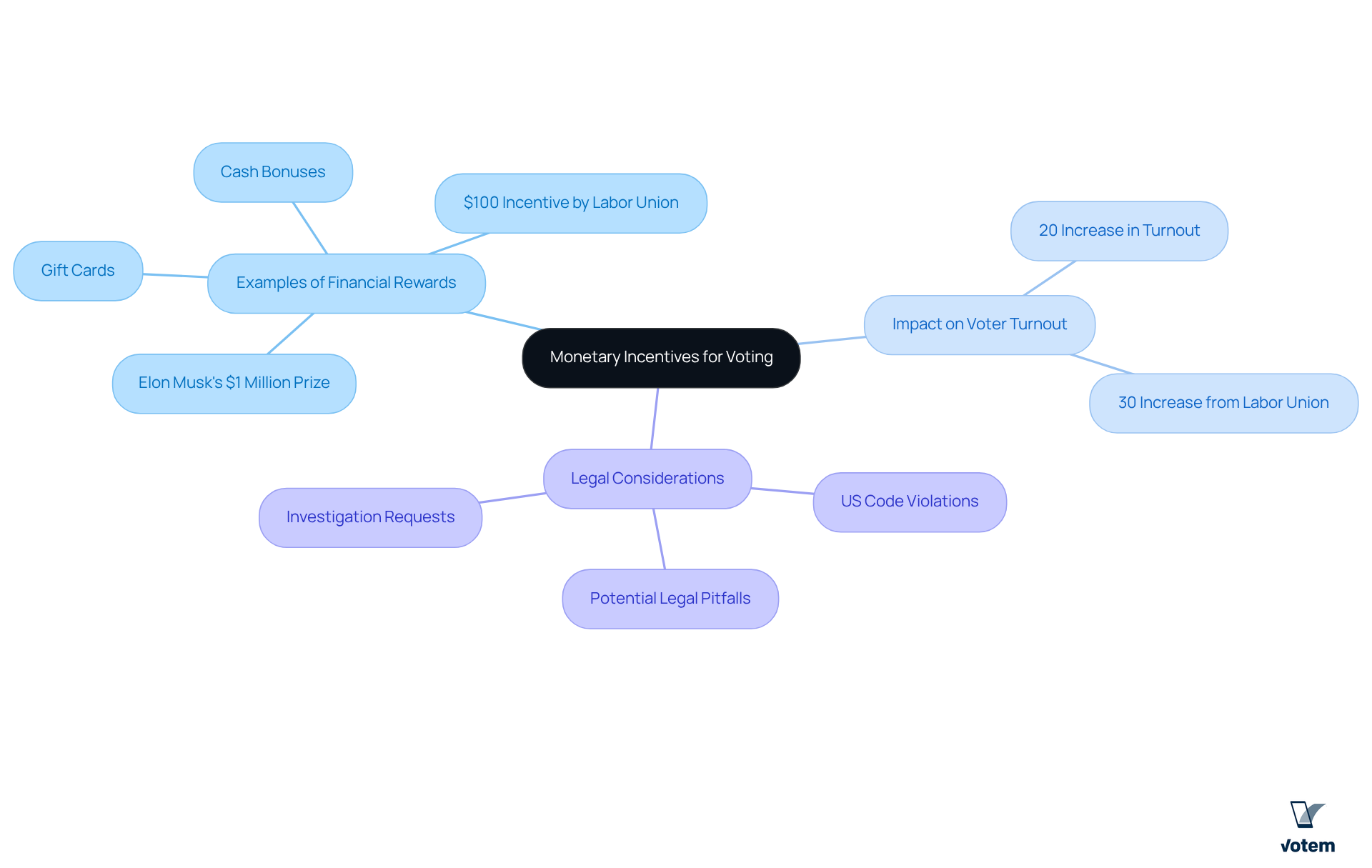
Community Surveys: Engaging Voters by Understanding Their Needs
Conducting community surveys is an essential resource for organizations aiming to assess the interests and concerns of their constituents. Understanding the issues that matter most to voters enables organizations to effectively customize their engagement strategies, including the use of voting incentives examples. This approach not only aids in crafting pertinent messaging but also serves as voting incentives examples that foster a sense of appreciation among individuals, thereby enhancing their likelihood of participating in elections.
As highlighted by Ted Van Green from the Pew Research Center, a notable 62% of U.S. adults believe that the decline in collective organization membership has adversely impacted working individuals. This statistic underscores the necessity of addressing participant concerns to enhance electoral engagement.
Furthermore, incorporating voting incentives examples to customize strategies based on participant feedback can lead to more effective outreach, ensuring that organizations remain attuned to the evolving needs of their constituents. Numerous organizations have successfully employed surveys to modify their electoral strategies, demonstrating a commitment to understanding and responding to feedback from their constituents.
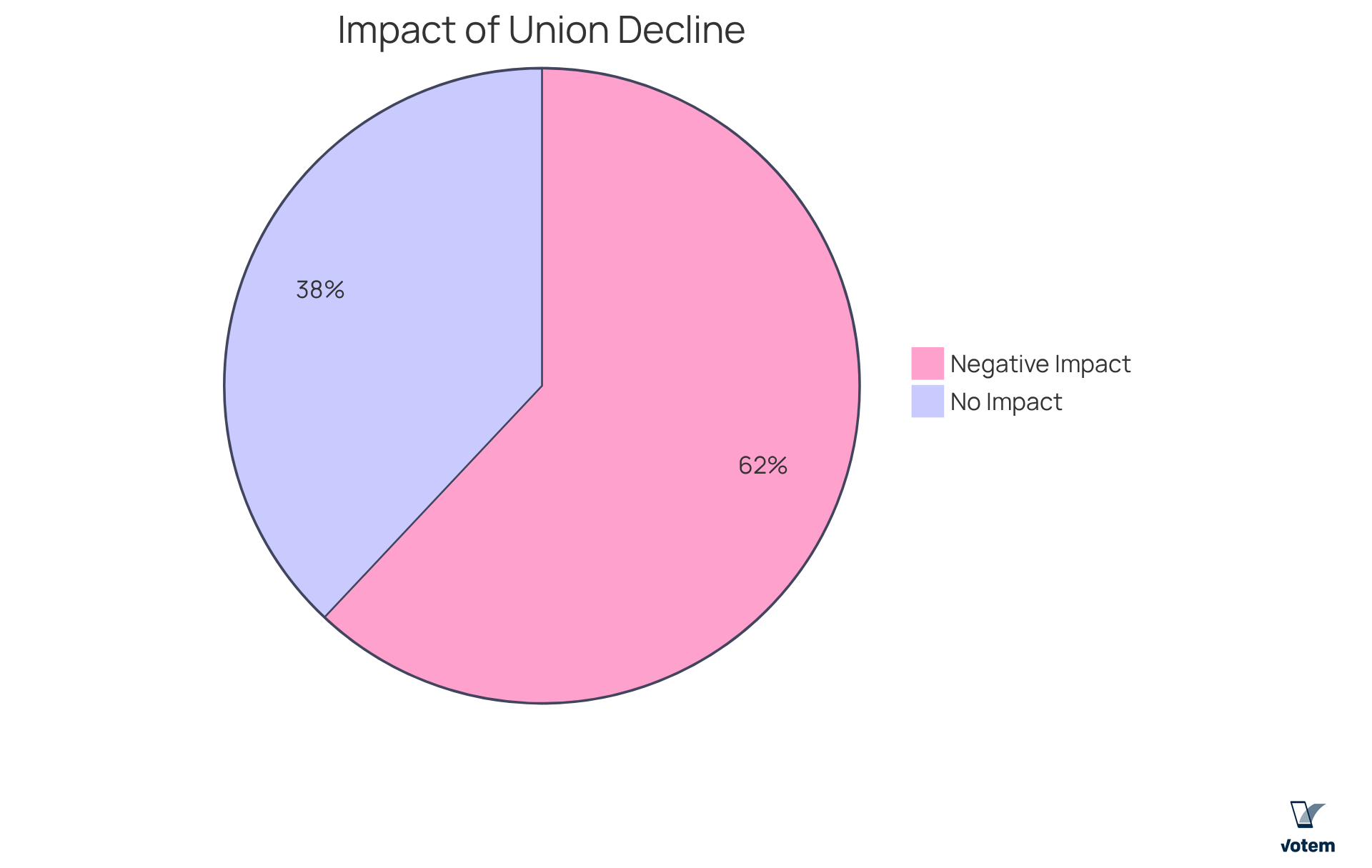
Reminder Emails: Encouraging Voter Participation Through Timely Notifications
Sending reminder emails to group participants before election day serves as one of the effective voting incentives examples to enhance participation rates. These communications must encompass essential information, including election dates, processes, and the significance of each participant’s vote. By delivering timely notifications, unions can effectively prepare and motivate their participants to engage in the electoral process.
Research shows that personalized emails, particularly those detailing specific voting incentives examples, can substantially boost turnout. Furthermore, integrating SMS reminders can amplify email initiatives, as SMS messages boast an impressive open rate of 98%, ensuring that crucial information reaches individuals swiftly.
As Amy Wood highlights, maintaining voter engagement post-election is vital for fostering connections leading up to the next election. Implementing these best practices provides voting incentives examples that not only cultivate a sense of civic responsibility but also reinforce the organization’s commitment to engagement and participation in the democratic process.
To maximize impact, unions should consider customizing their reminder emails with specific polling locations and emphasizing the importance of civic education campaigns to underscore the significance of local elections.
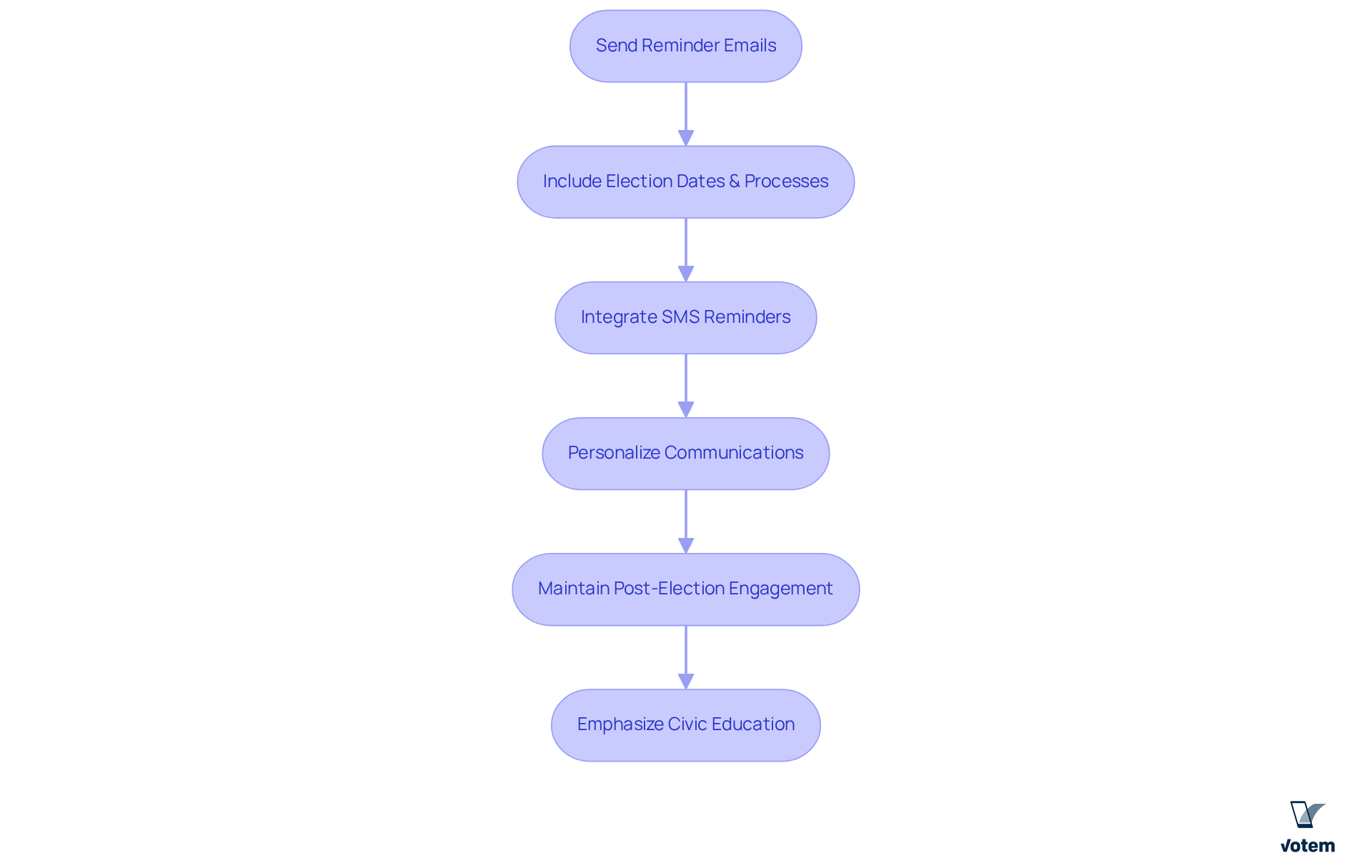
‘I Voted’ Stickers: Fostering Civic Pride to Encourage Voting
Distributing ‘I Voted’ stickers to members after they cast their ballots is one of the voting incentives examples that cultivates a strong sense of civic pride and community engagement. These stickers serve as compelling visual cues of participation and are great voting incentives examples that motivate others to engage in the electoral process.
For instance, the recent initiative in Palm Beach County introduced two unique Braille ‘I Voted’ stickers, designed to ensure inclusivity and celebrate diversity. One sticker features a pink flamingo, with its wing forming the American Sign Language sign for ‘I voted,’ while the other showcases a patriotic theme with a stylized American flag.
According to the Palm Beach County Supervisor of Elections Office, ‘This effort was designed to ensure all voters in Palm Beach County could experience the pride of receiving their I Voted sticker when casting their ballot.’ Such imaginative strategies not only improve accessibility but also emphasize the significance of voting incentives examples in encouraging participation in elections as a communal activity.
Furthermore, by promoting a culture that honors participation in elections through community activities and festivities, unions can greatly enhance overall involvement and turnout. This approach transforms the electoral process into a collective experience that resonates with all participants.
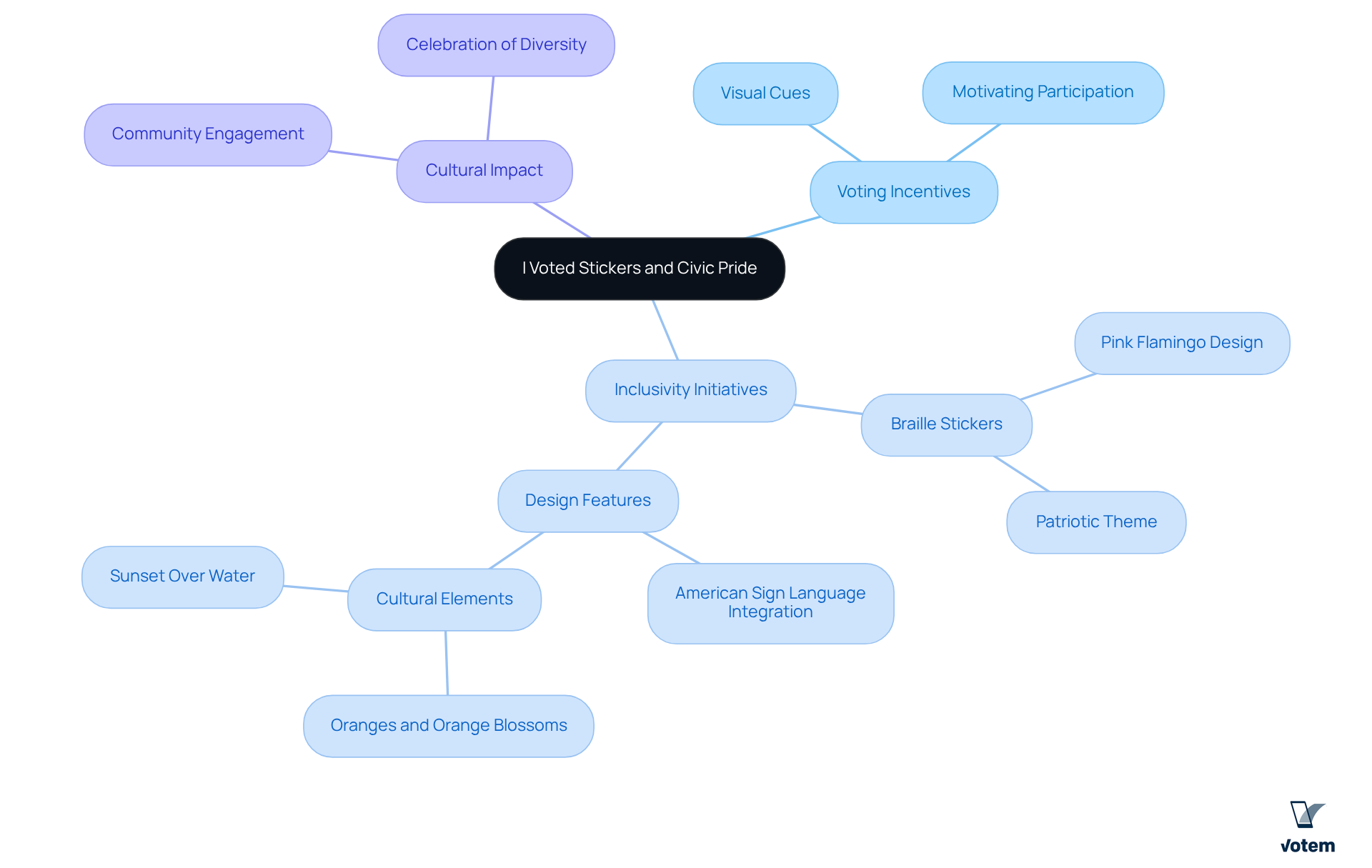
Enhanced Accessibility: Removing Barriers to Voter Participation
Ensuring that electoral processes are accessible to all members is essential for enhancing participation. Votem’s innovative online voting solutions have proven effective in this regard, as evidenced by testimonials from satisfied clients. For instance, one client noted that implementing Votem’s modern system allowed greater access for all qualified voters, including military personnel and individuals with disabilities. Furthermore, another client highlighted that Votem successfully handled the receipt of 299,000 votes for the National Radio Hall of Fame, a significant increase from the previous year’s 126,000 votes.
By actively striving to eliminate obstacles such as language barriers and physical challenges, organizations can foster an inclusive atmosphere that motivates all participants to engage in the electoral process. This dedication to accessibility not only encourages participation but also improves the overall security and integrity of the election process.
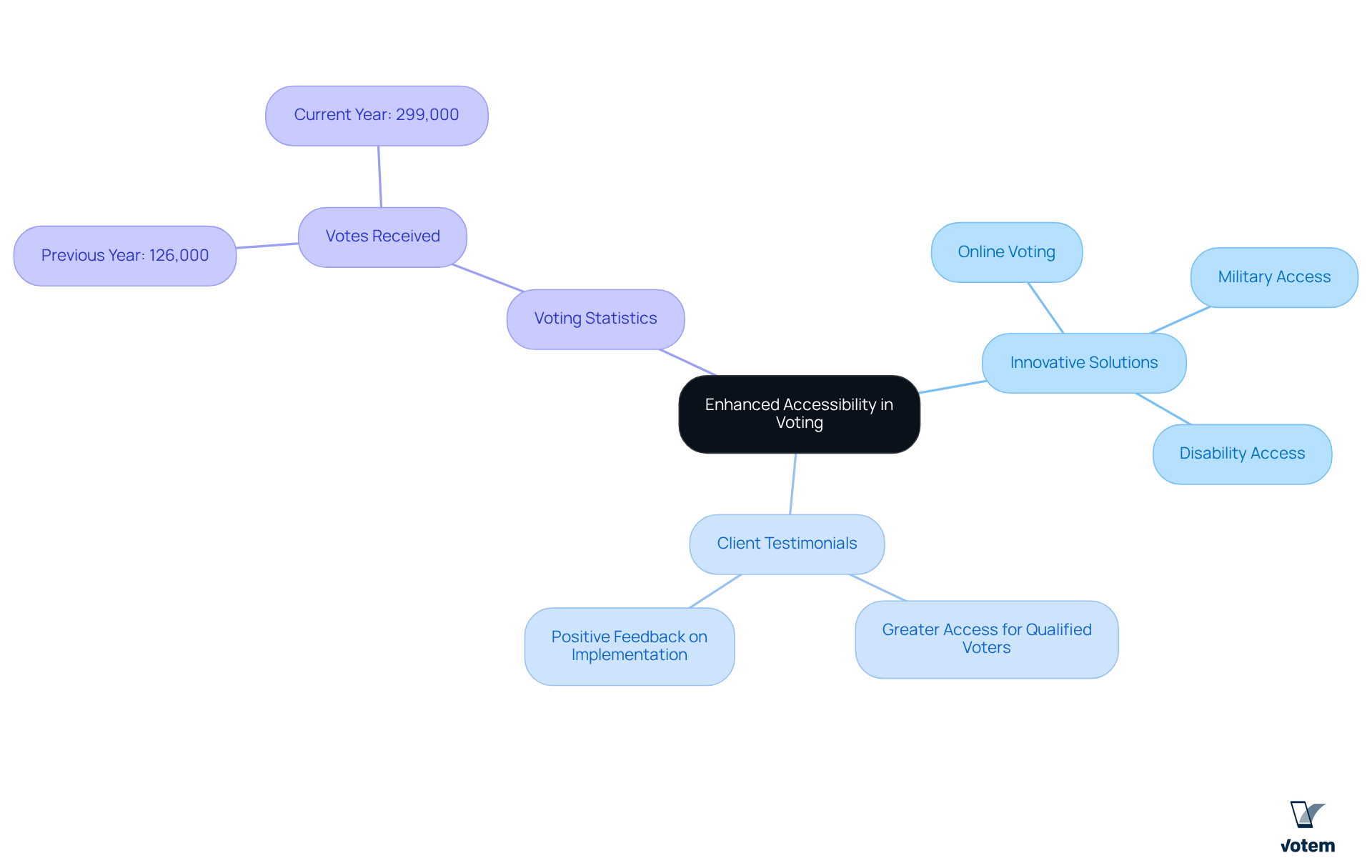
Civic Education Campaigns: Empowering Voters Through Knowledge
Civic education initiatives provide valuable voting incentives examples that empower members by equipping them with essential information for making informed electoral choices. These initiatives cover a range of topics, including the voting process, critical ballot issues, and voting incentives examples to promote active participation. Notably, studies indicate that regions with higher labor organization densities often experience increased electoral participation, with educational programs significantly contributing to this trend.
For example, in states with high union density, the average participation rate is markedly elevated, underscoring the effectiveness of well-informed electorates. Furthermore, a greater density of collective organization correlates with lower rates of voter restriction laws, further facilitating participation. By providing individuals with comprehensive information, organizations not only enhance engagement but also ensure that votes are cast with a clear understanding of their implications, ultimately fostering a more informed and active electorate.
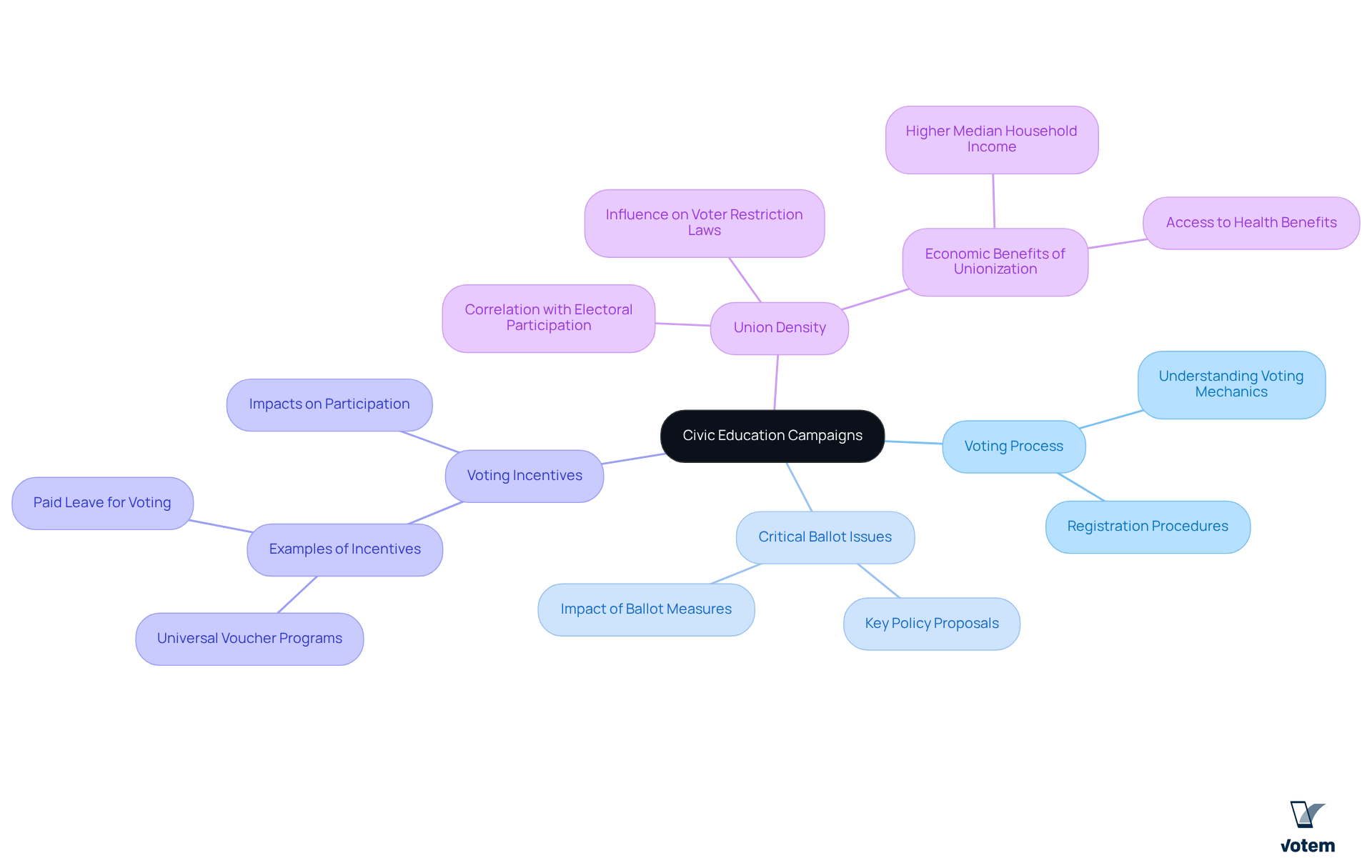
Early Voting Opportunities: Increasing Participation Through Flexibility
Offering early election opportunities empowers workers to cast their ballots at times that suit their individual schedules, a significant advantage for those balancing demanding work commitments or personal responsibilities. By promoting early ballot casting, which serves as one of the voting incentives examples, unions can bolster overall participation, ensuring that every member has the opportunity to express their voice.
Votem’s innovative online electoral solutions enhance this process, providing increased accessibility for all qualified individuals, including military personnel and those with disabilities. Furthermore, testimonials highlight Votem’s effectiveness, as evidenced by its management of significant increases in voter turnout, such as the successful handling of 299,000 votes for the National Radio Hall of Fame. This demonstrates the platform’s capability in engaging voters effectively.
By leveraging Votem’s technology, organizations can significantly enhance involvement and empower their members to exercise their electoral rights.
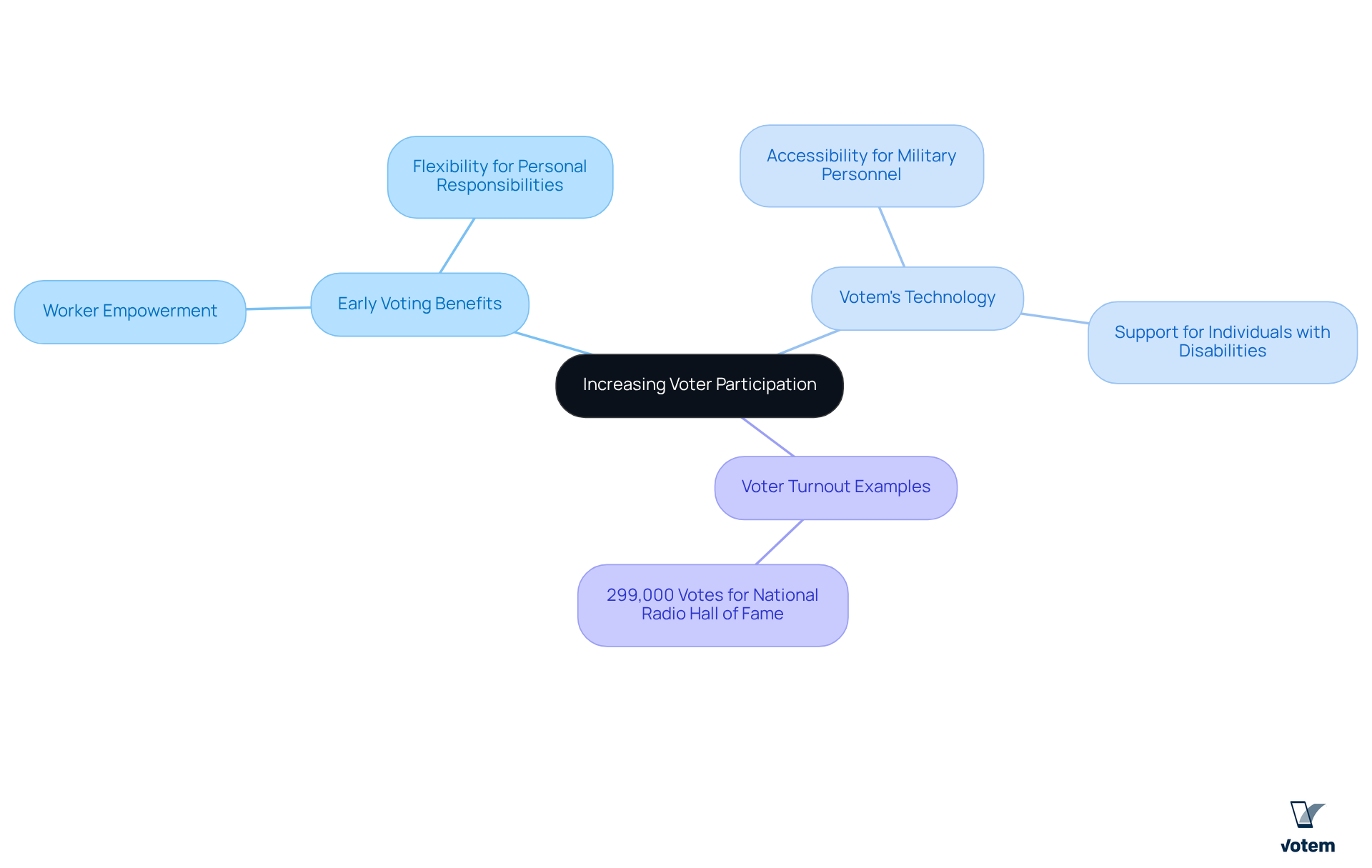
Mobile Polling Stations: Making Voting Accessible for All
Establishing mobile polling stations is a crucial step towards enhancing accessibility for workers. By introducing the election process directly to individuals in various locations, unions can effectively eliminate transportation barriers and present voting incentives examples to encourage greater involvement. Votem’s innovative online voting solutions have proven successful in boosting participation, showcasing voting incentives examples in testimonials that highlight a significant increase in votes for numerous organizations. This approach serves as one of the voting incentives examples that is particularly beneficial for reaching those who may struggle to access traditional polling sites, ensuring that every voice is heard and counted.
Furthermore, mobile polling stations can be viewed as voting incentives examples that not only facilitate participation but also foster a sense of community engagement. Union leadership has the opportunity to champion this initiative, demonstrating their commitment to inclusivity and representation. By leveraging Votem’s proven strategies, unions can create an environment that includes voting incentives examples to make voting accessible and straightforward. This method not only empowers individuals but also strengthens the democratic process within the workforce.
In addition, consider the testimonials from organizations that have successfully implemented these solutions. The rise in voter turnout is not just a statistic; it reflects the voices of workers who are eager to participate in shaping their future. By addressing the challenges of accessibility head-on, union leaders can inspire confidence and motivate action among their members.
Ultimately, the establishment of mobile polling stations represents a significant opportunity for unions to enhance participation and ensure that every worker’s voice is counted. As leaders, it is essential to embrace innovative solutions that promote accessibility and engagement in the electoral process.
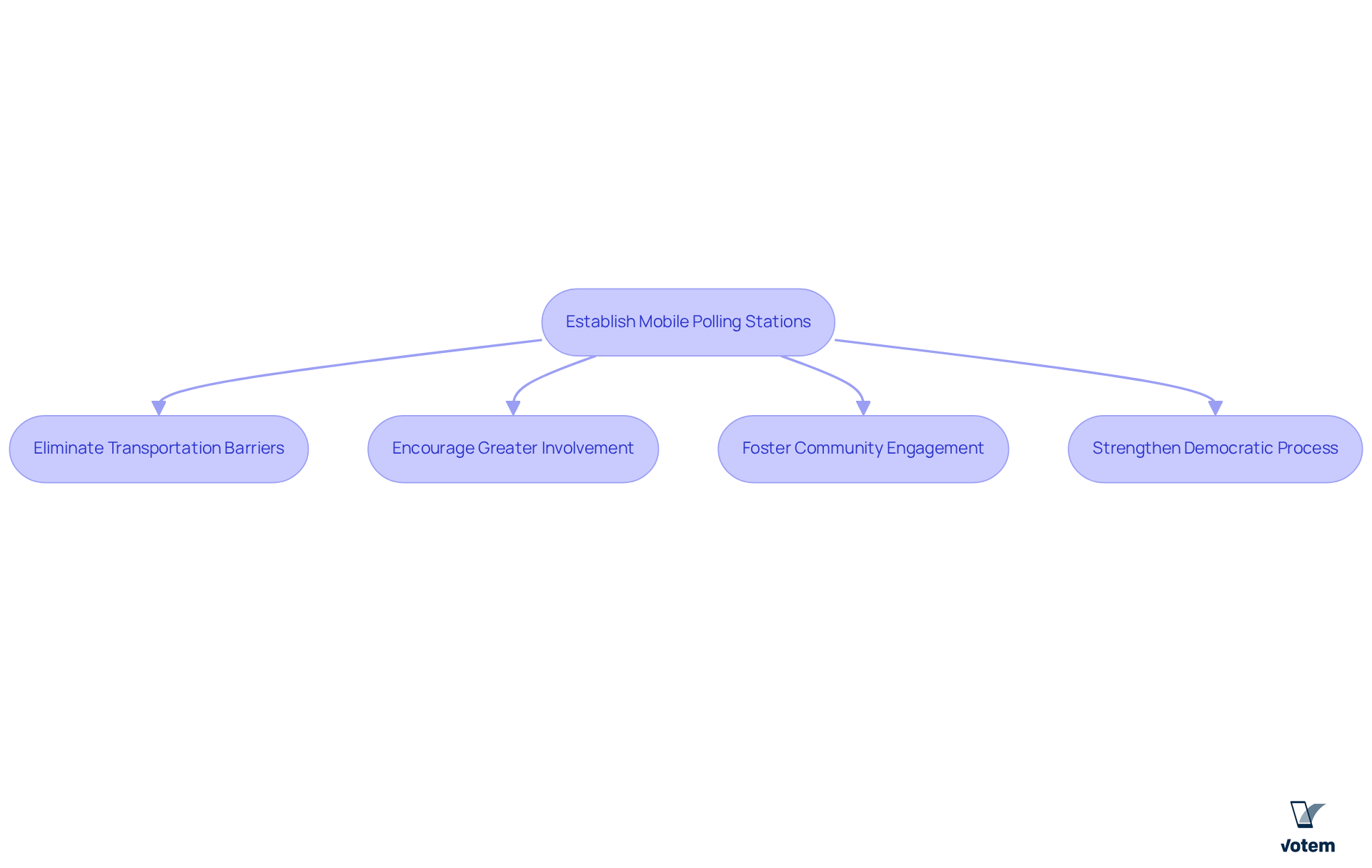
Transparent Communication: Building Trust to Enhance Voter Engagement
Transparent communication channels are crucial for unions seeking to establish trust and enhance voter engagement. Clear and accessible details regarding the electoral process are imperative; this includes addressing participant concerns and being forthright about election results. Research shows that transparency cultivates a sense of inclusion, which is one of the voting incentives examples that motivates members to participate in elections, as they feel their voices carry weight.
For instance, Votem’s innovative online voting solutions have significantly improved accessibility, enabling broader participation from diverse groups, including military personnel and individuals with disabilities. As Linda McCulloch remarked, ‘Implementing Votem’s new, modern system which allowed greater access for all qualified participants from military personnel to individuals with disabilities was my greatest accomplishment in office.’
Furthermore, Votem successfully managed the receipt of 299,000 votes for the National Radio Hall of Fame, reflecting a notable increase in voter turnout compared to previous years. By prioritizing transparency and leveraging modern voting technologies, unions can create voting incentives examples that foster an environment where members are more inclined to engage in the electoral process, ultimately leading to heightened participation and a more robust democratic foundation within their organizations.
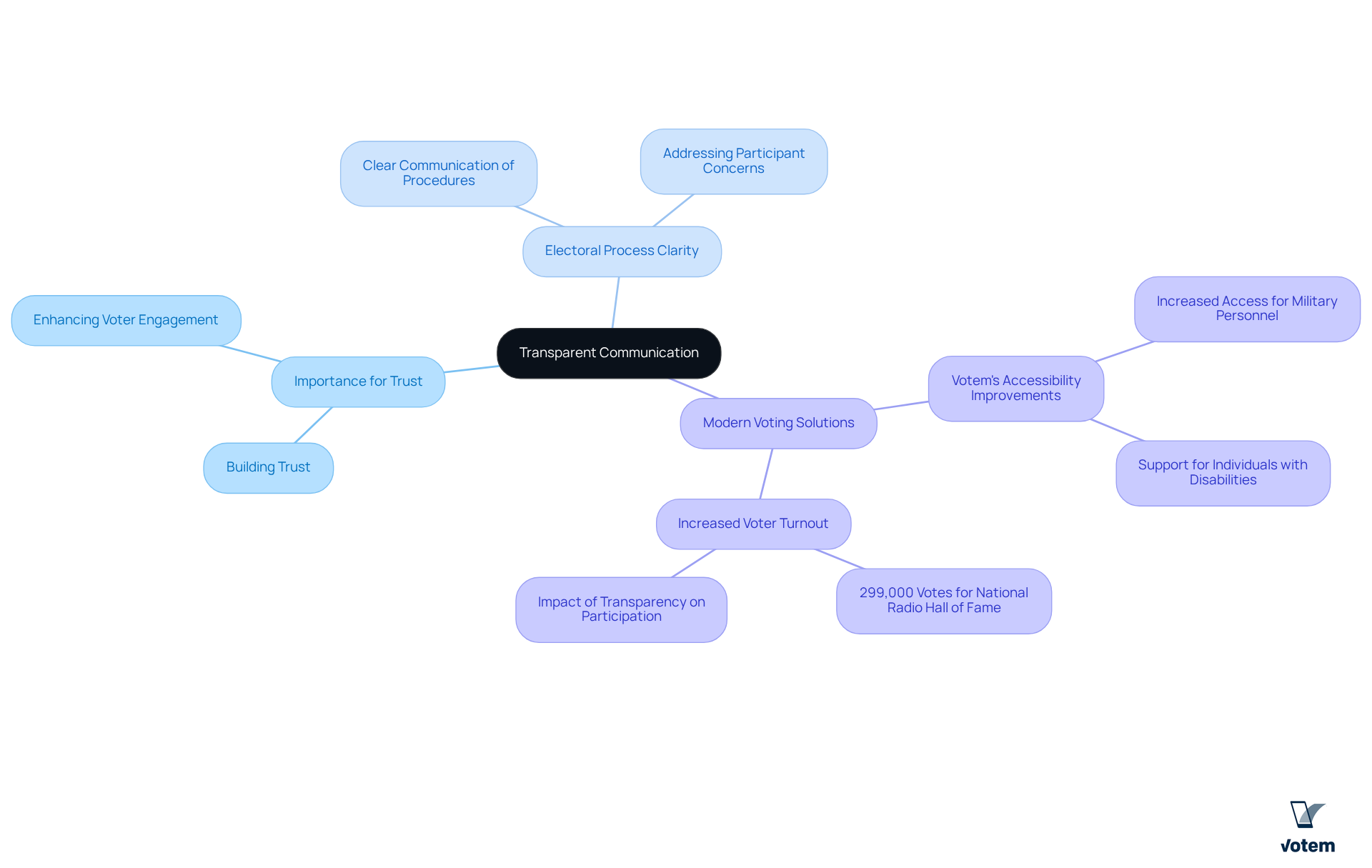
Conclusion
Implementing effective voting incentives is crucial for enhancing union member engagement and ensuring that every voice is heard in the electoral process. By utilizing innovative strategies—such as secure online voting platforms, financial rewards, community surveys, and transparent communication—unions can significantly boost participation rates among their members. These incentives not only facilitate a more inclusive voting environment but also foster a sense of community and civic pride.
Key insights from the article illustrate how various approaches—including reminder emails, early voting opportunities, and mobile polling stations—can effectively address barriers to participation. The evidence presented underscores the importance of understanding voter needs and preferences, which in turn drives engagement and cultivates a culture of active participation in the democratic process. Furthermore, the emphasis on accessibility and education highlights the critical role these factors play in empowering voters and enhancing turnout.
In conclusion, the significance of adopting comprehensive voting incentives cannot be overstated. Unions are encouraged to embrace these strategies not only to increase voter participation but also to strengthen the democratic foundation within their organizations. By prioritizing engagement and inclusivity, unions can ensure that every member’s voice contributes to shaping their collective future.
Frequently Asked Questions
What is Votem and how does it enhance voter engagement?
Votem is a secure online voting platform, specifically its CastIron platform, designed to enable secure and compliant online voting. It enhances voter engagement by making elections accessible, secure, and transparent, thus fostering trust among participants.
What features does Votem offer to ensure secure voting?
Votem offers features such as encrypted ballots and an immutable audit trail, which demonstrate its commitment to regulatory compliance and promote accountability and trust within organizations.
How does Votem’s mobile-first approach benefit voters?
Votem’s mobile-first approach allows members to vote conveniently from anywhere—at home, in the office, or on the go—significantly boosting participation rates.
What role do monetary incentives play in voter turnout?
Monetary incentives, such as gift cards or cash bonuses, can significantly enhance voter participation among affiliated workers by motivating them to engage in the electoral process and reinforcing the value of their votes.
Can you provide examples of successful monetary incentives for voting?
One example includes a labor union that offered $100 to members who participated in elections, resulting in a 30% increase in turnout compared to previous years. Other initiatives have shown turnout increases of up to 20% when financial incentives are provided.
What legal considerations should be taken into account with financial voting incentives?
Financial incentives must be structured carefully to comply with electoral laws to avoid potential legal pitfalls, as highlighted by experts like Paul Schiff Berman and former FEC chairman Brad Smith.
How can community surveys improve voter engagement?
Community surveys help organizations assess the interests and concerns of their constituents, allowing them to customize engagement strategies and voting incentives, which can enhance participation in elections.
What is the significance of understanding voter needs through surveys?
Understanding voter needs through surveys enables organizations to craft relevant messaging and outreach strategies, ensuring they are responsive to the evolving needs of their constituents and increasing the likelihood of electoral participation.
List of Sources
- Monetary Incentives: Boosting Voter Turnout Through Financial Rewards
- Is Musk’s $1m-a-day cash giveaway to US voters legal? (https://bbc.com/news/articles/ced0d1g5zyno)
- Community Surveys: Engaging Voters by Understanding Their Needs
- Majorities of adults see decline of union membership as bad for the U.S. and working people (https://pewresearch.org/short-reads/2025/08/27/majorities-of-adults-see-decline-of-union-membership-as-bad-for-the-us-and-working-people)
- Reminder Emails: Encouraging Voter Participation Through Timely Notifications
- 10 Strategies: Boost Voter Turnout in Local Elections | Blog (https://granicus.com/blog/10-strategies-to-boost-voter-turnout-and-engagement-in-local-elections)
- Erroneous election reminders sent to thousands of California voters (https://latimes.com/politics/story/2025-02-18/erroneous-election-reminders-sent-to-thousands-of-california-voters)
- Keeping Union Members in the Loop With SMS – CompleteSMS (https://completesms.com/blog/keeping-union-members-in-the-loop-with-sms)
- ‘I Voted’ Stickers: Fostering Civic Pride to Encourage Voting
- 2024 – Winner for Creative and Original “I Voted” Stickers | U.S. Election Assistance Commission (https://eac.gov/clearinghouse-awards/2024-winner-creative-and-original-i-voted-stickers-florida-72851)
- Civic Education Campaigns: Empowering Voters Through Knowledge
- Unions aren’t just good for workers—they also benefit communities and democracy (https://epi.org/publication/unions-arent-just-good-for-workers-they-also-benefit-communities-and-democracy)
- Transparent Communication: Building Trust to Enhance Voter Engagement
- Building voter trust on social media | MIT Election Lab (https://electionlab.mit.edu/articles/building-voter-trust-social-media)
- Workplace Communication Statistics (2025) (https://pumble.com/learn/communication/communication-statistics)
- Internal communications statistics: findings from Axios HQ 2025 annual report (https://axioshq.com/insights/internal-communications-statistics)
- Increasing Voter Participation in America (https://americanprogress.org/article/increasing-voter-participation-america)

